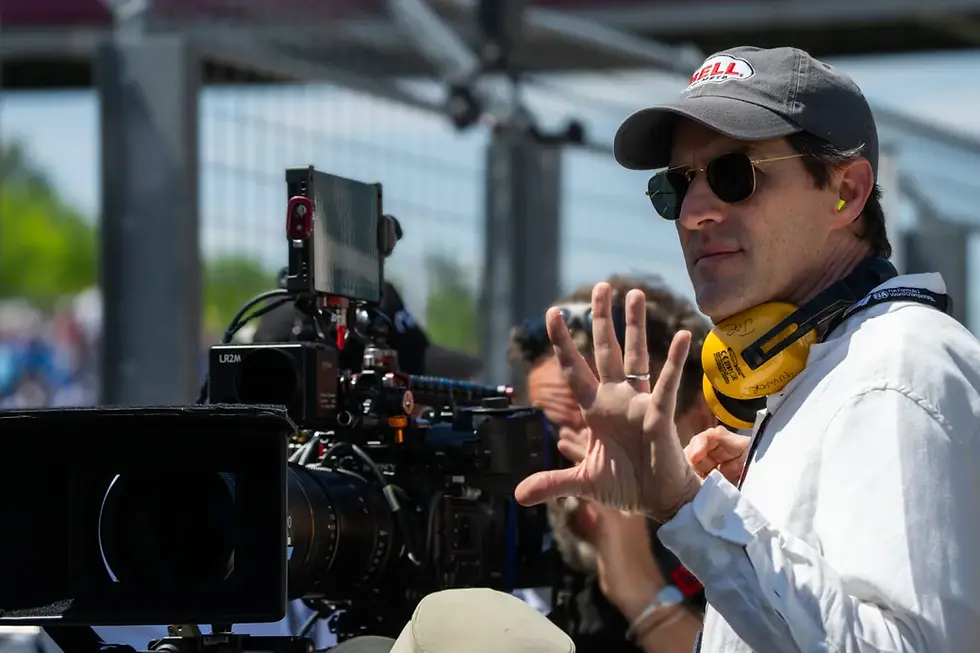Inside The Making Of “F1”: Using F2 Cars, Real Races, New Camera & VFX Technology
- Dan Lalonde
- Jun 28
- 4 min read

Do you want to see Days Of Thunder 2 crossover with F1?
Joseph Kosinski’s racing film F1, backed by Apple and produced by seven-time world champion Lewis Hamilton, is set to revolutionize the sports movie genre. Unlike traditional Hollywood racing dramas, F1 takes viewers deep into the actual race tracks, devoting the majority of its runtime to high-speed, real-world action.
With Brad Pitt and Damson Idris in the lead roles, the film integrates authentic Formula One events from the 2023 and 2024 seasons — a cinematic feat never before accomplished.
A New Benchmark in Realism

One of the most striking aspects of F1 is its unparalleled realism. The production team forged a groundbreaking partnership with Formula One, allowing them to shoot live during real Grand Prix weekends. Races in Las Vegas, Budapest, and Mexico City provided the dramatic backdrop, with real fans, live cars, and adrenaline-charged atmospheres — elements that even a $200M+ budget couldn’t replicate through CGI.
Actors Brad Pitt and Damson Idris underwent intensive training to drive modified Formula 2 cars at nearly 200 mph. These vehicles were altered by Mercedes F1 engineers to resemble Formula One cars while maintaining manageable operating costs and safety standards.
Why F2, Not F1?

Using real Formula One cars for the fictional Apex team was simply not practical. As Kosinski explained, a Formula One car requires a crew of about 30 people just to start, and costs approximately $250,000 per day to operate. In contrast, a Formula Two car — which offers about 90% of the performance — can be started by just two people and costs around $30,000 per day.
This cost-effective solution allowed the production to run multiple cars across multiple countries without breaking the bank, while still delivering intense speed and realism. And as Kosinski humorously noted, “Brad and Damson had no business operating in that upper 10% of performance anyway.”
Filming in the Heart of the Action

Capturing high-speed racing during live events presented a unique challenge. Executive producer Tim Bampton introduced a strict rule: the film could never interfere with the integrity of an actual race. As a result, Kosinski and his crew had to work with 5–15 minute windows between practice and qualifying sessions. Pitt and Idris were often on standby, engines warm, ready to hit the track for a single-take shot as soon as the opportunity arose.
One pivotal scene — shot just before the start of a live race — had to be completed in just eight minutes. The production team rehearsed for weeks using stopwatches to ensure perfect timing. This "live show" approach introduced a thrilling, real-time energy that sets F1 apart from traditional filmmaking.
Revolutionary Camera Technology

Kosinski’s goal was to replicate the cockpit immersion he achieved in Top Gun: Maverick, but with a major twist: race cars are far more sensitive to weight and aerodynamic changes. To address this, cinematographer Claudio Miranda and Sony co-developed a lightweight, high-performance camera system called Carmen — a sensor-on-a-stick designed to capture cinematic racing footage from within the cars.
Each Apex car (the film’s fictional team) was fitted with up to 15 of these Carmen camera sticks, with the camera bodies and RF equipment integrated into the car’s floor. This enabled flexible and dynamic in-car shots while preserving vehicle performance.
In collaboration with Apple, the filmmakers also created a compact, high-resolution camera using the iPhone sensor and iOS software to mimic F1’s traditional onboard pods. Remarkably, Formula One allowed these cameras to be installed in actual race cars during live events — an extraordinary first in sports cinema.
Integrating Real Races and Visual Effects

The film captures nine official Grand Prix events, including memorable real-world moments like Sergio “Checo” Pérez’s crash in Mexico and the Ocon-Gasly collision in Hungary. To integrate the fictional Apex team seamlessly into the footage, the VFX team “re-skinned” existing cars from live races. This technique — perfected in Top Gun: Maverick — allowed editors to overlay Apex’s livery onto real vehicles without compromising realism.
Director Kosinski ensured the integrity of each race’s results was preserved (with one exception), a promise made to drivers and teams. Meticulous editing logs allowed quick access to specific shots — like overtakes or pit stops — needed to advance the narrative.
Making Racing Accessible

While F1 caters to die-hard racing fans, the filmmakers also prioritized accessibility for general audiences. They recruited Sky Sports announcers David Croft and Martin Brundle to provide in-universe commentary. These familiar voices helped guide viewers through racing strategy and terminology without pausing the film’s momentum.
Croft and Brundle recorded over 19 hours of voiceover, enabling the editors to organically weave in exposition. This dual-layered approach ensured that both F1 veterans and casual viewers could enjoy the film without missing key plot points.
Conclusion: A New Era for Sports Films

With F1, Joseph Kosinski, Lewis Hamilton, and Brad Pitt have crafted more than a movie — they’ve engineered a seismic shift in sports filmmaking. By embedding actors within real races, using groundbreaking camera technology, and respecting the authenticity of Formula One, F1 promises to be a high-octane cinematic experience unlike anything Hollywood has ever seen.
Whether you're a long-time motorsport enthusiast or a curious newcomer, this film is set to deliver the raw speed, human drama, and cutting-edge innovation that defines the pinnacle of racing. Comment below with your thoughts.
Visit Dan Lalonde Films For All Technology And Entertainment News
Source: Indiewire
Photo Credit: Apple




Comments